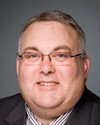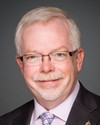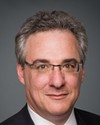Thank you, Chair.
Thank you for the opportunity to address the committee as it examines the final report of the federal electoral boundaries commission for Ontario, and I want to thank the commission itself for the excellent work it did in trying times with not being able to please everybody.
I'm appearing before you not as a complainant, but in response to an objection filed by the member for Eglinton—Lawrence, who seeks to transfer some 30,000 people from the western part of his riding to mine. I am here to object to his objection.
As you know, the commission for Ontario started its work in February last year with a mandate to fit 15 new ridings into the province. It had to respect geographical boundaries, community of interest, and try to limit variations in population to plus or minus 25% of the provincial target quotient of 106,213 people per riding, which is between 79,660 and 132,776 people.
The Ontario commission provided a proposal on possible riding boundaries in July of last year for broad public consultation, held hearings in October and November, including two days in Toronto, and presented its report to Parliament this past February. I participated in this process and made both a written and oral presentation to the commission. As you know, the commission recommended the status quo for both our ridings, which is a recommendation I support and my colleague from Davenport also supports.
It was not until I received notice of this committee's hearing that I became aware that the member for Eglinton—Lawrence had proposed something affecting my riding of York South—Weston. He did not consult with me or any of the communities I represent, and according to the commission itself, he did not propose this measure to the commission during its public hearings.
It was a total surprise to find out that there was an objection that would affect my riding and how significant a proposal it was. I'm disappointed that the member for Eglinton—Lawrence is not here today to speak to you about his proposal and give me the ability to respond to his concerns. I understand that Mr. Oliver will be providing you with written material to back up his objection, but I would ask for the opportunity to be able to review his material and respond to these arguments prior to this committee's making a recommendation.
My objection to the proposal being advanced by the member for Eglinton—Lawrence is based on two of the principles that guided the commission in its work. First, it creates a riding, my riding of York South—Weston that would greatly exceed the variation permitted for the population of ridings in Ontario. Second, it would join neighbourhoods that have no community of interest with York South—Weston.
The area of Eglinton—Lawrence that Mr. Oliver suggests should be transferred to York South—Weston lies between the CNR railroad tracks on the west, along Eglinton Avenue on the south, Allen Road on the east, and Highway 401 on the north.
This area, according to the 2011 census, is home to 30,887 people, nearly one-quarter of my current riding. The addition of this area to my riding would create a federal electoral district of 147,493 people, which is 138% of the target population quotient for Ontario, well above the 125% guideline. It would create the largest riding in terms of population in Ontario. There's no justification for this.
Second, there is no community of interest for the neighbourhoods between the CNR tracks and the Allen Road in the Eglinton—Lawrence and the communities I represent west of these railway tracks. This was a factor recognized by the commission in its report when it considered proposals affecting our mutual boundary of the railroad tracks.
Indeed, the municipal electoral boundary for the City of Toronto between ward 12 in the east part of my riding adjoining ward 15 on the west side of Mr. Oliver's riding is the CNR railroad tracks. These tracks are a significant physical barrier dividing these communities, penetrated only by Lawrence Avenue, Castlefield Avenue, and Eglinton Avenue over a 3.7 kilometre length.
It is absurd to suggest adding 30,000 people to a riding that is already within 10% of the provincial quotient as my riding of York South—Weston is. To bring us back to that target population quotient would have a large domino effect on neighbouring ridings, basically, redoing the commission's work in Toronto.
There is no justification for this. Mr. Oliver is trying to solve a problem the commission has already dealt with and, instead, is creating more problems than can be reasonably dealt with by this committee today. I would ask therefore that this committee reject Mr. Oliver's objection to the commission's recommendation regarding Eglinton—Lawrence on the basis that it artificially joins to York South—Weston neighbourhoods with whom there is no community of interest and, in so doing, creates a riding that is far too large, exceeding the commission's guidelines for appropriate riding population.
I would be happy to answer any questions you have.




